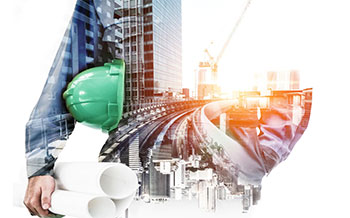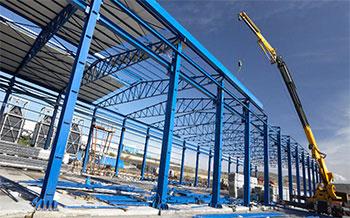
FACTORY BUILDING DESIGN
FACTORY BUILDING DESIGN
Pre-Engineered Factory Building
Industrial construction is revolutionised by pre-engineered factory buildings, which use an efficient and streamlined method. These constructions are created off-site utilising cutting-edge engineering techniques, and they are erected on the site akin to a massive jigsaw puzzle. The walls, roofing, and steel frames are among the components that are expertly made to fit together flawlessly. By cutting construction time so much, this method minimises disruptions to operations and saves money.
Pre-engineered factory buildings are adaptable and can be customised to satisfy particular industry standards. These structures guarantee longevity and durability thanks to their strong design and premium materials. All things considered, pre-engineered factory buildings offer a cutting-edge, economical, and timely solution for industrial infrastructure.
Features Of Pre-Engineered Factory Building
Factory buildings that have been pre-engineered come with various features that make construction easier, increase productivity, and guarantee longevity. These structures offer an economical and efficient solution because they are specially made to satisfy particular industrial needs. Structural integrity and resistance to inclement weather are guaranteed by the use of premium steel components. Expanding or changing the design as business needs change is made simple by the modular structure.
Furthermore, sophisticated insulation systems are incorporated into pre-engineered buildings, increasing energy efficiency and lowering operating expenses. Project timelines are accelerated by quick assembly, which is made possible by precision engineering and standardised components. Pre-engineered factory buildings offer a flexible and contemporary solution for industrial needs with their customisable layouts, clear-span interiors, and integration of cutting-edge technology.
Factory building design is utilized to design changes when a factory or creation line is to be altered. Factory shed design is additionally used to plan and layout totally new factories. This organized cycle includes the orderly, objective arranged design of factories. It traverses different stages going from functional investigation and starting format to execution and authorizing. The design process is upheld by different instruments and strategies. Factory building design is a significant retribution calculate plant layout. Working of satisfactory aspects and appropriate plan must be constructed or procured for installation of the plant expected to do the arranged manufacturing process.
Dairy Factory design construction
The design and construction of dairy factories require careful planning and execution to produce hygienic and effective facilities for milk processing. The plan must take into account several phases, from receiving raw milk to packaging the finished product. It's important to consider elements like workflow optimisation, sanitation, and equipment placement. Sufficient space is necessary for processing apparatus, storage, and office spaces to guarantee a smooth functioning.
Construction materials need to be hygienic, and facilities need to follow rules and regulations. Automated processing lines are examples of advanced technologies that are frequently integrated to improve productivity and preserve product quality. Functionality, regulatory compliance, and operational efficiency must all be balanced for the design of a dairy factory to be successful.
Application of Dairy Factory design construction
In order to maximise a dairy factory's functionality and efficiency and guarantee a smooth production process, design and construction are essential. Careful planning is applied in the design of dairy factories, taking into account elements like workflow, equipment placement, and layout to maximise efficiency and hygienic conditions. To construct a facility that satisfies regulatory requirements, construction materials and methods must follow industry standards.
Maintaining high-quality dairy production requires easy cleaning and maintenance, which is made possible by a well-designed dairy factory. Modern environmental practices are also in line with the use of sustainable and energy-efficient features in construction. To put it simply, a strong, compliant facility that prioritises quality and sustainability over output can only be built by carefully applying the principles of dairy factory design and construction.
Modern dairy consultant
In order to maximise productivity and guarantee efficiency in the dairy industry, a contemporary dairy consultant is essential. These specialists are well-versed in the most recent technological advancements, market trends, and legal specifications. Their main duty is to provide advice to dairy farms and processing facilities regarding the adoption of cutting-edge machinery, modernization of their infrastructure, and adoption of sustainable practices.
Consultants assist in streamlining operations, cutting expenses, and increasing overall productivity by examining supply chain logistics, quality control procedures, and production processes. Modern dairy factory consultants play a major role in the success and sustainability of dairy businesses in today's dynamic market. They have expertise in areas such as automation, waste management, and product diversification.
Tips for choosing Modern dairy Factory consultant
A crucial choice that can have a big impact on the success of your company is selecting a consultant for your contemporary dairy factory. The following are some essential pointers to help you with your selection process:
Expertise: Seek consultants who have in-depth knowledge of the latest technologies, regulations, and dairy practices.
Track Record: To evaluate their success and dependability, look at their previous work and client endorsements.
Customization: Look for advisors who are able to modify plans to fit your unique requirements.
Technology Integration: Make sure the consultant can integrate the newest dairy processing technologies with ease and is knowledgeable about them.
Regulatory Compliance: To guarantee legal compliance, confirm that they are aware of both domestic and global dairy regulations.
Communication: To promote an easy working relationship, select a consultant with effective communication skills.
Cost-Effective Solutions: Assess suggestions for how to cut costs without sacrificing quality. You can find a consultant who shares your vision and helps your modern dairy factory succeed by taking these factors into account.
Factory Building Design: Balancing Functionality and Efficiency
The design of a factory building plays a crucial role in ensuring the smooth and efficient operation of manufacturing processes. A well-designed factory not only optimizes productivity but also ensures worker safety, maximizes space utilization, and supports future expansion. This essay explores the key factors and considerations involved in the design of a factory building, highlighting the balance between functionality and efficiency.
Layout and Flow:
An efficient factory design starts with careful planning of the layout and flow of materials, people, and machinery. The layout should promote a logical and streamlined workflow, minimizing unnecessary movement and bottlenecks. Key considerations include grouping related processes together, ensuring a smooth flow of materials from one stage to another, and providing clear pathways for employees and machinery. A well-designed factory should also anticipate future growth and allow for flexibility and scalability in layout adjustments.
Space Utilization:
Optimizing space utilization is vital for maximizing production capacity and minimizing operational costs. Efficient factory designs employ strategies such as vertical integration, mezzanine floors, and strategic placement of equipment and workstations. Clever utilization of overhead space and innovative storage solutions can free up valuable floor space, allowing for increased production capacity without the need for expanding the building's footprint.
Safety and Ergonomics:
Worker safety is of paramount importance in any factory environment. The design of a factory building should prioritize safety measures, including clear emergency exits, well-placed fire suppression systems, and appropriate ventilation systems to maintain air quality. Additionally, ergonomic considerations play a significant role in ensuring employee well-being and productivity. Proper workstation design, comfortable seating, and easy access to tools and equipment can reduce the risk of injuries and promote a healthier work environment.
Lighting and Environmental Considerations:
Well-planned lighting is essential for factory operations. Sufficient natural and artificial lighting should be provided to ensure optimal visibility in all work areas. Properly designed lighting not only enhances worker productivity but also contributes to overall safety and reduces the likelihood of errors and accidents. Furthermore, incorporating sustainable design principles into factory buildings, such as energy-efficient lighting systems and renewable energy sources, can minimize environmental impact and contribute to long-term cost savings.
Integration of Technology:
Modern factory designs incorporate advanced technologies to enhance efficiency and productivity. Automation and robotics play a significant role in optimizing manufacturing processes, reducing human error, and increasing output. The design should accommodate the integration of machinery and technology, including the provision of adequate power supply, data connectivity, and space for equipment installation and maintenance.
Environmental Control and Waste Management:
Certain manufacturing processes require specific environmental conditions, such as temperature and humidity control. Factory designs should include HVAC systems that can regulate and maintain these conditions. Additionally, waste management systems should be incorporated into the design to facilitate proper disposal and recycling of materials, minimizing environmental impact and adhering to sustainability goals.
Conclusion:
Factory building design is a complex process that involves careful consideration of various factors. Balancing functionality and efficiency is crucial to create a productive and safe working environment. By focusing on layout and flow, space utilization, safety and ergonomics, lighting and environmental considerations, technology integration, and environmental control, a well-designed factory building can optimize production processes, support growth, and contribute to the overall success of a manufacturing operation.









